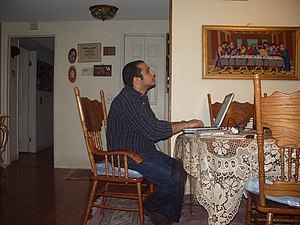Our website is made possible by displaying online advertisements to our visitors.
Please consider supporting us by disabling your ad blocker.
Portal:Internet
The Internet PortalThe Internet (or internet) is the global system of interconnected computer networks that uses the Internet protocol suite (TCP/IP) to communicate between networks and devices. It is a network of networks that consists of private, public, academic, business, and government networks of local to global scope, linked by a broad array of electronic, wireless, and optical networking technologies. The Internet carries a vast range of information resources and services, such as the interlinked hypertext documents and applications of the World Wide Web (WWW), electronic mail, internet telephony, and file sharing. The origins of the Internet date back to research that enabled the time-sharing of computer resources, the development of packet switching in the 1960s and the design of computer networks for data communication. The set of rules (communication protocols) to enable internetworking on the Internet arose from research and development commissioned in the 1970s by the Defense Advanced Research Projects Agency (DARPA) of the United States Department of Defense in collaboration with universities and researchers across the United States and in the United Kingdom and France. The ARPANET initially served as a backbone for the interconnection of regional academic and military networks in the United States to enable resource sharing. The funding of the National Science Foundation Network as a new backbone in the 1980s, as well as private funding for other commercial extensions, encouraged worldwide participation in the development of new networking technologies and the merger of many networks using DARPA's Internet protocol suite. The linking of commercial networks and enterprises by the early 1990s, as well as the advent of the World Wide Web, marked the beginning of the transition to the modern Internet, and generated sustained exponential growth as generations of institutional, personal, and mobile computers were connected to the internetwork. Although the Internet was widely used by academia in the 1980s, the subsequent commercialization of the Internet in the 1990s and beyond incorporated its services and technologies into virtually every aspect of modern life. (Full article...) Selected article
Cyberpunk is a genre of science fiction that focuses on computers or information technology, usually coupled with some degree of breakdown in social order. The plot of cyberpunk writing often centers on a conflict among hackers, artificial intelligences, and mega corporations, tending to be set within a near-future dystopian Earth, rather than the "outer space" locales prevalent at the time of cyberpunk's inception. Much of the genre's "atmosphere" echoes film noir, and written works in the genre often use techniques from detective fiction. While this gritty, hard-hitting style was hailed as revolutionary during cyberpunk's early days, later observers concluded that in terms of literature, most cyberpunk narrative techniques were less innovative than those of the New Wave, twenty years earlier. Primary exponents of the cyberpunk field include William Gibson, Bruce Sterling, John Shirley and Rudy Rucker. The term became widespread in the 1980s and remains current today.
Selected picture A blog (a portmanteau of web log) is a website where entries are commonly displayed in reverse chronological order. "Blog" can also be used as a verb, meaning to maintain or add content to a blog. Many blogs provide commentary or news on a particular subject; others function as more personal online diaries. A typical blog combines text, images, and links to other blogs, web pages, and other media related to its topic. On March 22, 2016, software engineer Azer Koçulu took down the Several hours after the package was removed from npm, the company behind the platform, npm, Inc, manually restored the package. Later, npm disabled the ability to remove a package if more than 24 hours have elapsed since its publishing date and at least one other project depends on it. The incident drew widespread media attention and reactions from people in the software industry. The removal of WikiProjects
Did you know (auto-generated) -
Selected biography
Chad Meredith Hurley (born 1977) is co-founder and Chief Executive Officer of the popular San Bruno, California-based video sharing website YouTube, one of the biggest providers of videos on the Internet. In June 2006, he was voted 28th on Business 2.0's "50 people who matter" list. In October 2006 he sold YouTube for $1.65 billion to Google. Hurley worked in eBay's PayPal division before starting YouTube with fellow PayPal colleagues Steve Chen and Jawed Karim. One of his tasks at eBay involved designing the original PayPal logo. Newsweek describes Hurley as a user interface expert. He was primarily responsible for the tagging and video sharing aspects of YouTube. YouTube was born when the founders (Hurley, Chen, and Karim) wanted to share some videos from a dinner party with friends in San Francisco in January 2005. Sending the clips around by e-mail was a bust: The e-mails kept getting rejected because they were so big. Posting the videos online was a headache, too. So they got to work to design something simpler. In 11 months the site became one of the most popular sites on the Internet because the founders designed it so people can post almost anything they like on YouTube in minutes.
General images -The following are images from various internet-related articles on Wikipedia.
Selected quoteMain topics
Featured contentCategoriesRelated portalsThings you can do
Associated WikimediaThe following Wikimedia Foundation sister projects provide more on this subject:
Wikipedia's portals |
Previous Page Next Page























































